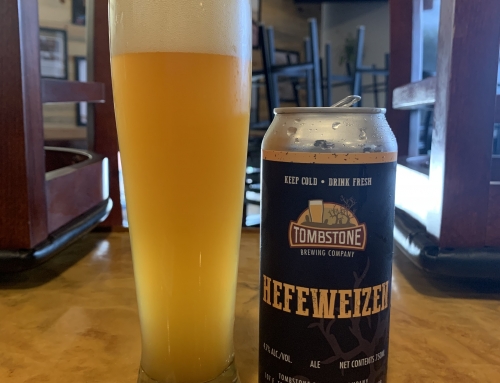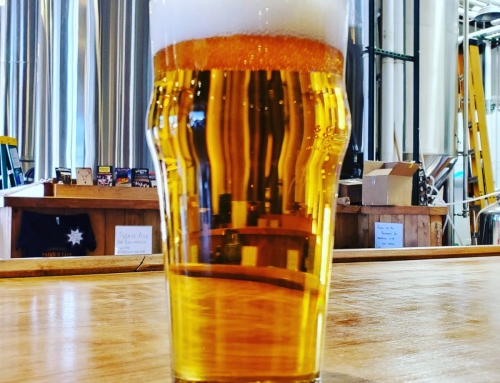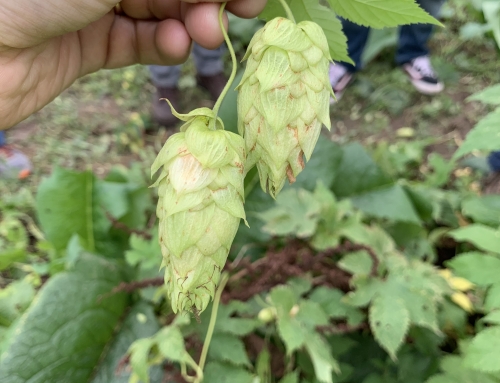It’s been a fun week at the brewery! After releasing a new IPA over the weekend, we brewed three entirely new beers that we’re excited to share soon.
First up, we have “Not Really a Barleywine.” As anyone who has followed Tombstone from the beginning knows, lighthearted trolling is right up our alley. In the past, we’ve named beers “Another Exercise in Mediocrity” and “Over and Out” after dealing with some criticisms online. This time around, we’re having a good time with the recent explosion in barleywine popularity.
When I drank my first barleywine back in 2008, J.W. Lees vintages were all the rage on beer forums. In fact, I think they had 3 versions of it in the BeerAdvocate top 100 when I started following the site. I got my hands on a 1997 Lagavulin Cask Harvest Ale. It wasn’t at all what I expected, and sadly, my 18 year old self hated it and dumped half the bottle. I thought it was flat, not sweet enough to support the Scotch flavor, and there was a load of sediment in the bottle that I didn’t understand how it would get there. So I thought it was a bad bottle.
Over the next couple years, I continued to try bottles of different vintages and grew to love the style and began to appreciate that the carbonation level was low to help with the drinkability. I started enjoying traditional barleywines so much that, as a 19 year old homebrewer, I brewed a 5 gallon batch with 100% floor malted Maris Otter, a 5 hour boil, and used only the first runnings of my mash, which resulted in a beer that finished at 15.5% ABV. It aged in a keg for about 5 years, when I finally remembered that it existed and started giving out samples at homebrew club meetings and to friends on special occasions. The last time I tried that beer, it was 8 years since the brew date and I forgot about it and left it in Alabama when I moved to AZ with about 3 gallons still remaining. At that point, the aging had turned the beer into something truly special; still boozy and super bready from the Maris Otter, with hints of tobacco, sherry, and raisins.
When we first opened, I wanted to brew another traditional English style barleywine with 100% Maris Otter, a long boil, flavorful English Ale Yeast, a healthy dose of bittering hops, and low carbonation levels…like the way barleywines had been brewed for almost the entire history of the style. That batch went almost entirely into barrels and was released to our barrel society. It didn’t go over all that well, with complaints about the carbonation level being low, not being sweet, too thin, etc. Those were all the complaints that I had about traditional English barleywines when I’d first started drinking.
So last summer, we were noticing the growing popularity of barleywines and we thought we’d give it another shot, but we added some caramel malts, carbonated the beer to a higher level, and we brewed it to a higher gravity. Half the batch went into cans, half into barrels, and most of the barrels were released to our second year barrel society with a much better reception. Cans of the non-barrel aged version were reasonably well liked, but we kept seeing comments saying “Good, but not as dark as a traditional barleywine.” or “Not really a barleywine, but still pretty good.”
I began to question what people thought a barleywine entailed. So I started looking around and what I noticed was that a lot of those reviewers were a.) Newer beer drinkers and b.) were drinking extremely dark, almost black “barleywines” and referring to them as “traditional.” It became clear that my preferred way of brewing a barleywine is old school, behind the times, and sadly, not relevant for modern craft beer drinking palates. These new barleywines are something entirely different from actual traditional barleywines. I like them in their own way, but they’re almost unrecognizable as being related to the traditional examples. In a lot of ways, the beers we’re seeing are more closely related to stouts without as much roasty intensity, or roasty, but non-astringent. So we decided to give in and brew this beer, but being unprepared to give up the “fight” about what makes a barleywine a barleywine, we couldn’t help but show people what our definition of “Not Really a Barleywine” actually means!
In a nod to the traditions of barleywine brewing, we used floor malted Maris Otter for the base malt and a flavorful English Ale yeast. We used a very vigorous boil and a combination of specialty malts for rich toffee, sweet caramel, and a thick bodied barleywine that will result in an 11% ABV beer, half of which is going into a mix of bourbon, Jamaican Rum, Scotch (if you dislike peat smoke, stay away!), and Tequila barrels. The other half of the batch will go into cans and a small amount of draught will be available. While we’re having a good time with some mild trolling and a little bit of smack talk, I’d be lying if I said I’m not really excited about this beer and the opportunity to brew something a little different from what I’ve done in the past.
The day after our barleywine brew day, we hosted our good friend Ian “Beer Guy” Harwell from Ground Control for a collaboration brew day. Ian had some awesome art work done for the can featuring himself in a wrestling ring with a hop leaf… Probably my favorite can art from us. For the beer, we are using Pils malt from a new maltster (Proximity) that impressed us with their samples. It is highly uncommon that anyone can convince me to try something outside of Weyermann or Crisp malts, but the uniformity of the malting, biscuit and light honey flavors in the samples were exciting and it seemed to me that it would be the perfect base malt to show off some bright pineapple, grapefruit, and light floral/herbal aromas from my favorite Michigan grown hops out of Hop Head Farms.
It was a double batch brew day for us, so batch two of the day was the first beer in a new series of IPA’s that we’re calling “Bright and Juicy.” A few months ago, I was talking with some customers that mentioned to me that they like our style of IPA’s, but that they also liked lighter colored NEIPA’s with a “brighter” hop aroma. Their comment got me thinking that I do tend to focus on the melon, berry, peach, and dank aromas in our IPA’s and I’ll use our “bright” aroma hops only for providing balance to the heavier, more intense aromatics. We do have access to several really great hop lots of hops that I would consider to be bright, such as our Amarillo which provides a ruby red grapefruit flavor when we use it in a blend with other citrusy hops.
Being a brewer that is always looking for brewing a wide variety of beers, I wanted to start this series to co-exist with our current IPA’s that are a bit darker from our Maris Otter malts, and have the heavier aromatics. This first batch of our Bright and Juicy is featuring floor malted Bohemian Pils malt for a pale color and it has proven to be a good base for other hoppy beers we’ve brewed recently, such as our Double IPA Dry Hopped with Nelson and Mosaic. Perhaps the most exciting thing about this batch is the hop combo of all Oregon grown hops.
As I’ve mentioned in past posts, my trip to Oregon last September for the hop harvest was incredible. I found several hop lots that I couldn’t believe how great they smelled. Two hops in particular stood out when I smelled them: Comet (which we brewed a single hop IPA with) and Strata. The Comet stood out in part because it’s normally not thought of as a very exciting hop, but Crosby Farms first year of growing it yielded a hop that I considered to be special and a testament to their soil conditions and climate. Strata was a new one for me and we were fortunate to get a couple of boxes for this year as well as a contract for next year. This Bright and Juicy will be the first beer from us to feature it and we anticipate a huge amount of passionfruit aroma combined with the ruby red grapefruit of our Amarillo to be the dominant aromas.
Our last upcoming new beer is a pale lager that we intend to be for brewery only release in cans and draught throughout Cochise County. We are fortunate to live in a state where craft drinkers have come back around to appreciating lagers and where the bar is set high, due to many years of craft breweries producing world class lagers. We have our lager tanks filled right now and our process is a little bit unique for these beers in that we fermented them entirely in the shallow lagering vessels. We used a previously released, popular lager (Oktoberfest) recipe and scaled it down to a lower ABV, with a dryer finish, but it still displays all the malty flavor that we get from Vienna and Munich malts in our traditional Oktoberfest recipe. At 4.9% ABV and 7 IBU’s, this is going to be a light lager that still packs an intensity of flavor that most people will not expect from a low abv, pale lager, while simultaneously retaining all the drinkability that people look for in a light beer.




Hands down best beers in AZ bar NONE…I would go as far as to say best west of the Mississippi but I have yet to taste the leaders of the East Coast pack. I can honestly taste the love of craft, freshest hope and the attention to detail in every sip. Hats off Tombstone…keep doing you.